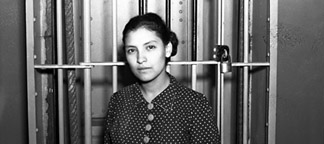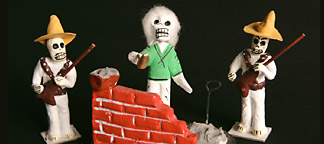  |
|
On the altar Altar for Emma Tenayuca October 15 through November 6 4 - 8pm, Wed - Fri; 2 - 8pm, Sat & Sun 5555 Morningside, Suite 204 Houston, TX 77005 (713) 521-3686 Event Information The Mexican tradition of El Dia de los Muertos (Day of the Dead) is held annually on November 2 (All Souls' Day) to remember family members and friends, and to honor ancestors' traditions. The Ofrenda (altar) is quite simply a way to get to know someone who is no longer living. Time spent making the altar and having it in the home inspires family members and friends to be reacquainted with someone they love. Most altars are created using regional and family customs, and they carefully honor the traditions of ancestors. The altar and many activities associated with creating it (such as leaving trails of Marigold petals) are to guide the spirit of the deceased back to the home. Preparations for the return of the spirit are made in late October. Altars for children (angelitos) are prepared for November 1 (All Saints' Day). Items placed on the altar are of personal, spiritual and traditional value. Photographs and possessions evoke memories. Certain keepsakes bring to mind favorite stories. Cakes, fruits and drinks offer favorite foods and nourishment for the spirit╣s return. Symbols and icons represent beliefs - often both ancestral indigenous beliefs and Christian beliefs. Public altars may raise awareness of faith, issues, and influential people. Altars in public parks and schools may be dedicated to the Virgen de Guadalupe, the women who have been murdered in Juarez, or heroes like Cesar Chavez. Some items on Emma's altar include: Cornbread (Represents a story from Emma's childhood) Emma told this story to an oral historian working for the University of Texas-San Antonio: I don't think I ever had any birthday cake until I actually demanded it. But [her birthday, December 21] was so close to Christmas, and with tamales, bu˝uelos, and fruitcakes being made, there wasn't any time to bake the cake for me.Pecans (Represent the pecan shellers whose lives, among others, Emma worked to improve) Emma was exposed to workers' issues growing up on the west side of San Antonio during the Mexican Revolution and the Great Depression. She witnessed the treatment of textile workers and pecan shellers during the industrial boom that exploited mostly Mexican-American and migrant labor in San Antonio and south Texas. Emma became a labor organizer and relief worker, and lobbied city and Works Progress Administration officials for better conditions. She staged sit-ins and protested abuses by the newly-formed border patrol. Emma organized for the Women's League for Peace and Freedom, International Ladies' Garment Workers' Union, and the Workers Alliance of America as a teenager and through her 20s. [The labor movement was] the salvation of all those who were hungry, and there were many.... it's only recently that I have been able to talk about some of the things that I saw here as far as poverty. The poverty was just too difficult.Photographs (Represent influences in Emma's life) Known for her commitment to activism for poor workers and political change, Emma (national committeewoman for the Workers Alliance of America at age 20), is pictured standing before her cell after she was arrested and charged with disturbing the peace during a June 30, 1937 sit-in in San Antonio, as she lobbied WPA officials on behalf of struggling Mexican-Americans. Emma is also pictured with friends at the train station happily returning from New York, where she received treatment for tuberculosis and attended a Communist Party meeting. Her heroes were women who changed the role of women in the early twentieth century, including: Mother Jones (talking with Calvin Coolidge) and Eleanor Roosevelt, who are picture on the altar. Emma was impressed by their influence in policy matters. Emma stated: "I just have a feeling, a very strong feeling, that if ever this world is civilized that it would be more the work of women." Elizabeth Gurly Flynn, a labor organizer for the Industrial Workers of the World (a union that represented many working class people regardless of race, sex, or nationality. The IWW was created in 1905 by dissident Socialists who separated from the AF of L because of its restrictive "white male only" policy). Babe Didrikson Zaharias, an influential Texas athlete who competed in numerous sports and was said to be able to compete with top male athletes in baseball, basketball and golf. Emma told of her and a friend getting in to see Didrikson play even though they only had enough money for one ticket. Karl Marx is pictured on the altar. Emma read Marx' books Value, Price and Profit and Wage, Labor and Capital. She was interested in alternatives to capitalism as she witnessed the abuse of workers in the industrial age. She said, "If you have not read anything about the Great Depression, then I think you should... because that was one time that the bottom fell out of your free-enterprise system." Lasca Fortassain, an employee of San Antonio mayor Maury Maverick (who issued a permit for Tenayuca to hold a Communist Party meeting in the Municipal Auditorium) told an oral historian, "You have to recognize that in those days it was not against the law to be a Communist. As a matter of fact, a lot of the young intelligentsia were... they taught the idea that there were advantages in a system in which we were not all working for ourselves but had some concern for the group as a whole." Emma's use of the Municipal Auditorium for a political rally resulted in one of the city's most notable controversies as influential organizations demanded she be barred from the public facility. Fortassain reported, "Maury (Maverick) said, 'These people have paid their fee, and they are citizens of the United States. They have asked to rent the room, and they have as much right to rent it as anybody else'." Orchestrated rioters attacked the Municipal Auditorium and made threats against Emma and the mayor. Major companies blacklisted Emma for her efforts to organize workers and her affiliation with the Communist Party. Emma moved away from San Antonio to San Francisco to become a teacher. She was an avid reader and was critical of policy makers throughout her lifetime. She commented: "Unfortunately, American history books, especially at the high school level... were not analytical. They were not critical. You will find history books that will tell you that we still don't know why the depression occurred, the worldwide depression. I am disappointed by the intellectuals of America... We've been spending too much money on armaments. We haven't had any peace since World War II. We've had troops in Korea, Vietnam, South America, Europe... We cannot continue to do that." Emma followed the social movements of Latin American nations following her retirement from teaching in 1982, and remained an outspoken critic of American intervention in Central America, stating, "I was reading this morning's paper. Why covert actions? Why make the policy of our country a terrorist one under people such as North and Poindexter?" And she lamented, "I would hate to see another Carter or another movie star [Reagan] because they don't know foreign policy; they don't know history." Hopefully this altar offers some insight into the life and spirit of Emma Tenayuca. Learn more about Emma Tenayuca: houstonculture.org/hispanic/tenayuca.html |
| TRADITIONS OF MEXICO PROJECT OVERVIEW HOUSTON INSTITUTE FOR CULTURE |